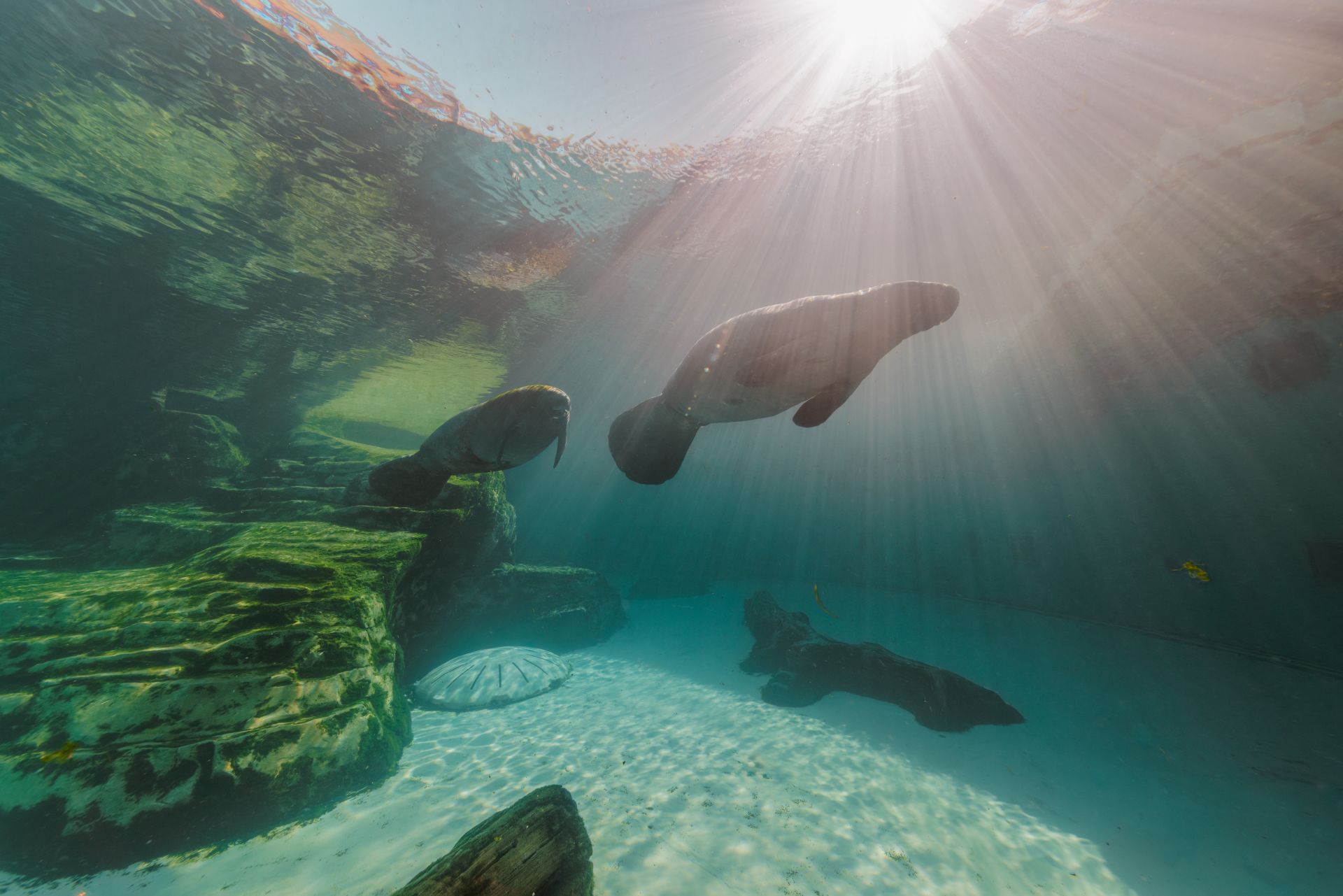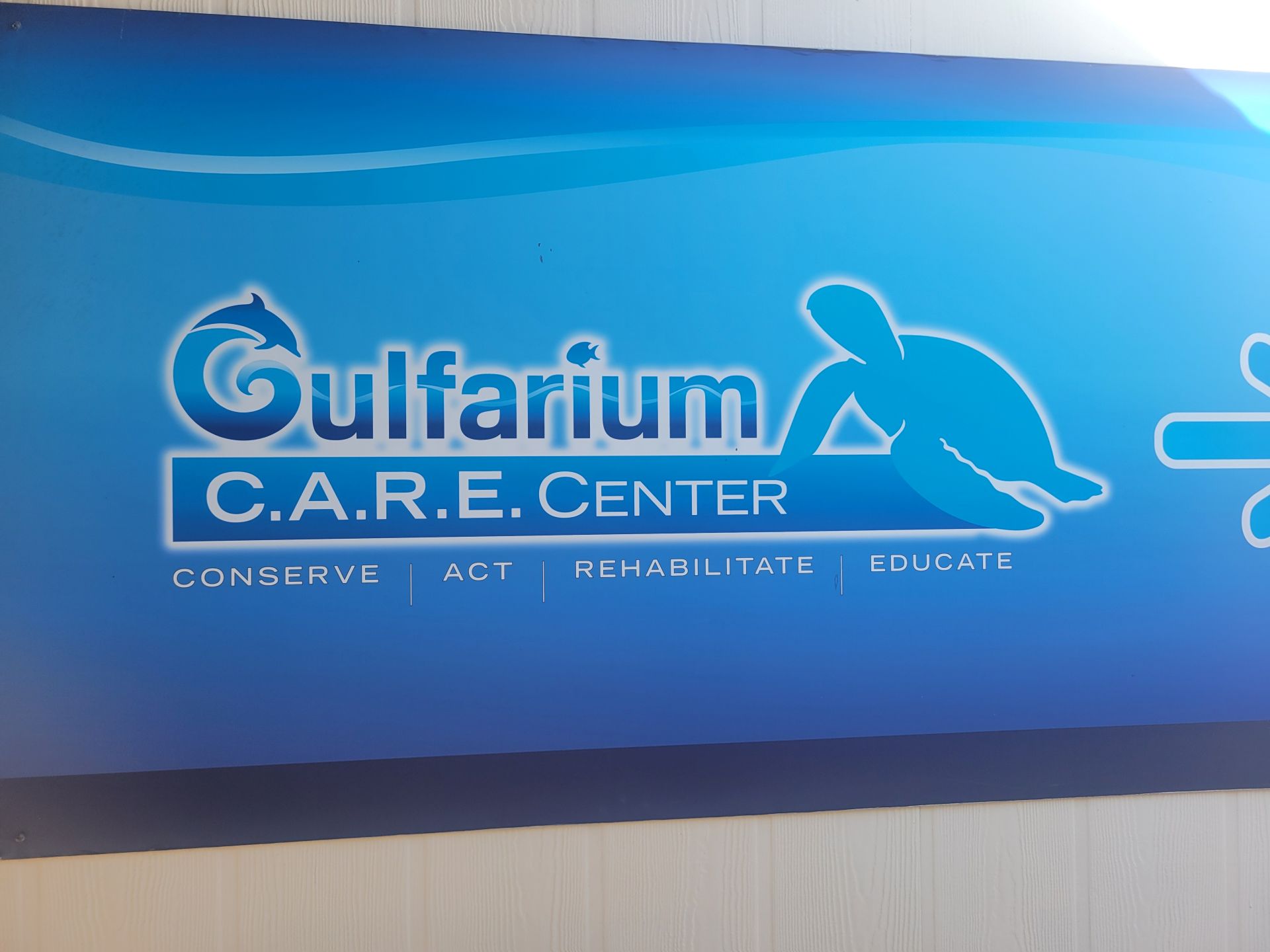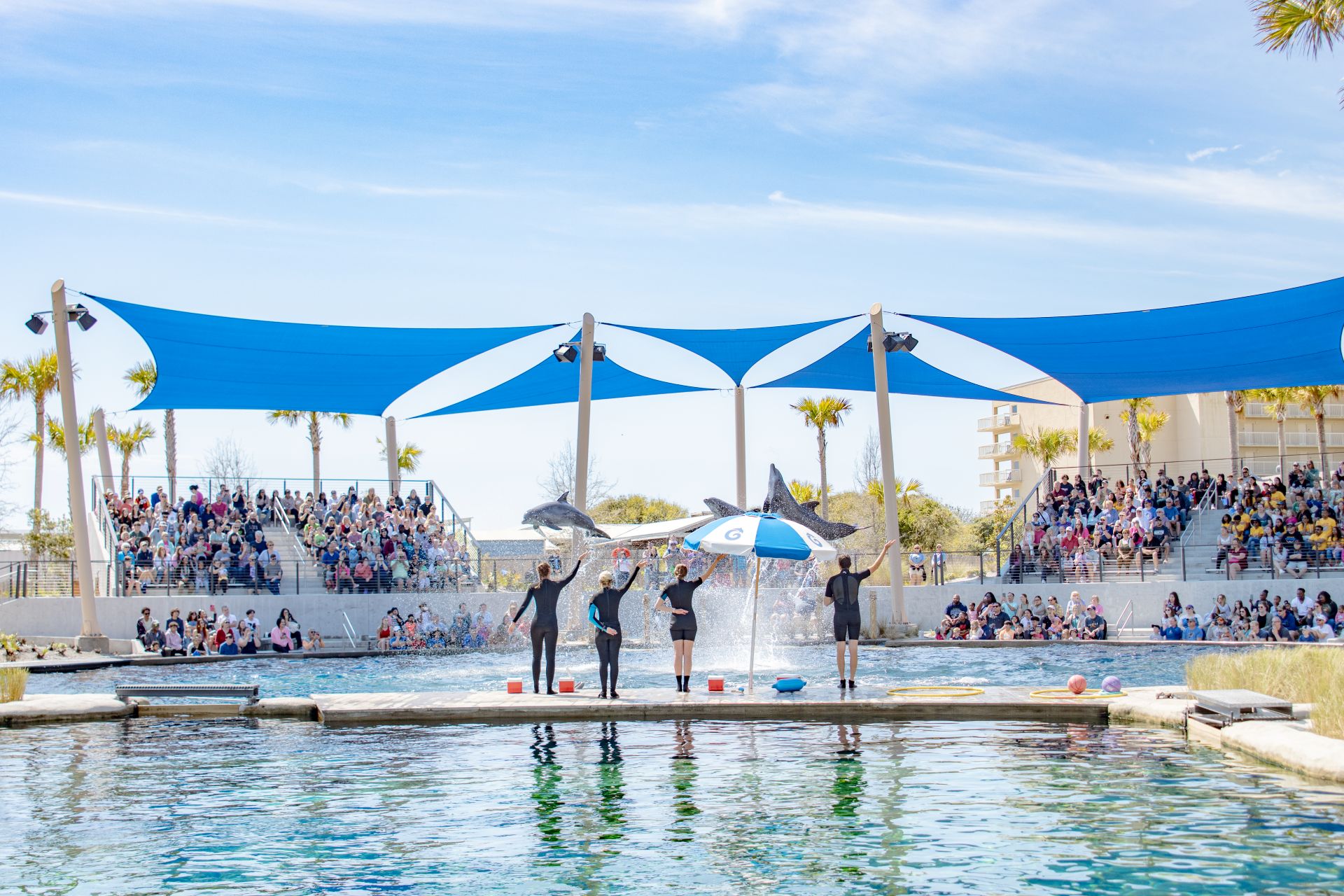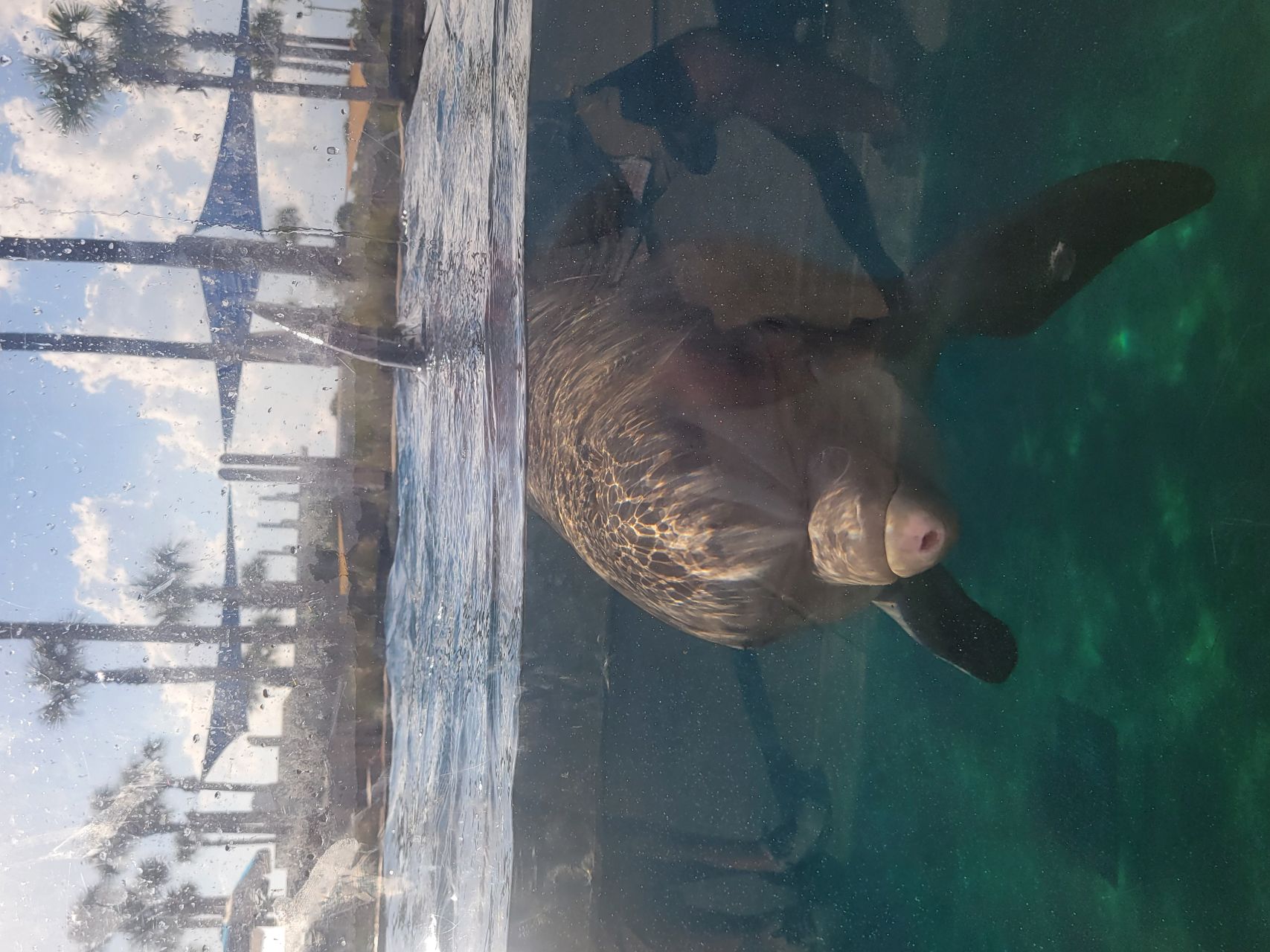
On a recent trip to the Emerald Coast, Linda and I went to the Gulfarium Marine Adventure Park in Destin / Fort Walton Beach. This was my first time visiting the park in about 50 years, but it certainly felt familiar. It was Fall Break, and there were lots of families enjoying the beautiful weather. Of special note, the park is celebrating its 70th anniversary this year.
Our guide for the afternoon was Ashley Erickson, Operations Manager for the Gulfarium. As we entered, she told us that there had been a lot of changes in the last couple of years, including a newly expanded 2-acre dolphin habitat. The manatee exhibit, Manatee Cove, is the former dolphin habitat that was retrofitted specifically for rescued manatees less than a year ago. Three manatees are lazily swimming in the large habitat, eating Romaine lettuce, and lounging about as manatees do.
“All three of our manatees are rescued. Romeo is over 70 years old and is the oldest manatee on record. Every day, he sets a new record.” Ashley tells us, “Little Joe is an orphaned calf who now weighs about 1650 pounds. Inigo is the youngest at about 9 years old.” Each manatee eats about 75–80 heads of lettuce a day while being nursed back to health.”
Patrick Berry, CEO of the Gulfarium, is away at a conference meeting of the Manatee Rescue Rehabilitation Partnership (MRP) of which he is a board member. The MRP is a conservation organization that the Gulfarium plays a part in. The collaborative rescues and rehabilitates manatees throughout the state. “These are conditional non-releasable statused animals,” Ashley tells us. “Manatees' teeth are all ‘marching molars', meaning when they get ground down, new molars push forward from the back.”
After visiting with the rescued manatees, we head through the park’s reptile exhibit. There are different enclosures and landscaped habitats for snakes and alligators, including an albino alligator in its early teens. “There are fewer than 50 in the world. Because they have no way to camouflage, there is little or no chance they can survive in the wild.” There is also a Chinese Alligator, which is a smaller species I’d never heard of before.
We then take in the Backwater Nursery, where the American Alligators are. They breed a “clutch” at the same time every year. When the juveniles are one year old, they are sent to education centers to prepare the Park for the new clutch to prevent overcrowding.
Ashley has been the Operations Manager for over two years, but has been with the park for over six years. She has a biology degree, but tells us that her experience in leadership from her years in the military was a good fit at the Gulfarium. During the high season, the park has a staff of 125 to 130, and 80 or 90 during the off-season. “We employ some local high school students in the summer as well, giving them a great first job exposure to guest service and other career opportunities," she says.
We then pass the Gulfarium C.A.R.E Center (Conserve-Act-Rehabilitate-Educate), where we observe several large round pools of sea turtles. All have been rescued and are being treated for injuries before being released back into the wild. We meet Arugula and Poppyseed, two turtles who are recovering from ingested hooks, propeller strikes, and such. “Poppyseed is a repeat offender,” says Ashley. “She was rescued, recovered, released, and rescued again. She’s doing well and weighs 230 pounds.” She has been back in the C.A.R.E. facility for the second time since August 2, 2025. She was scheduled to be released later that week.

The overall focus of the park and its programming is on ocean conservation and education. Ashley tells us that there are a lot of volunteer opportunities at Gulfarium, many centered on the C.A.R.E. program. They host an annual Sea Turtle Festival called “Care on the Coast” that draws a good crowd and helps to raise money for the Center. This coming year’s event will take place on April 18, 2026.

“There are programs offered throughout the year, and we have school groups coming from all over to learn and experience the Gulfarium. Our outreach adventures and school programs are designed for different grade levels. We also host a variety of special events from weddings to company gatherings, birthdays, and more. These events can range from 15 to 150 people to many hundreds more at a time.”
We then moved to the newest habitat on the campus, Dolphin Oasis. Here, with several large interconnected habitats throughout, which mimic the beauty of the Emerald Coast, we find trainers playfully interacting with the mammals. They seem to be having fun, and it’s an amazing sight to watch. There are opportunities for Gulfarium guests to get close and interact with the dolphins, all under professional animal care supervision.

Right on cue, two very large dolphins jumped in unison out of the water and began swimming on their back while waving their flippers. They look happy and return to their trainers to retrieve their fit for human consumption fish treats. We learn that the dolphins are also supplemented with water from a tube for extra hydration. They get their hydration from all the fish that they eat as well.

The dolphin trainers at Gulfarium have backgrounds in biology, zoology, animal husbandry, and many with a minor degree in psychology. As we moved to the area with an underwater Plexiglass viewing station, each dolphin was asked to come say hello, which they happily did. It was a cool experience.

Ashley explains that dolphins don’t sleep in the same way that humans do. They have to consciously take a breath, so rather than falling asleep like we do, they have an ability to rest one half of their brain; it goes into a resting state, and they will slow down their activity level at this time as well.
As the day is winding down and the park is closing, we pass several other animal habitats, including sea lions, harbor seals, sting rays, and a warm-weather penguin enclosure. “These are African penguins. We have to heat this area when we have cold weather, even in Destin/ Fort Walton Beach.” Next, we pass Nurse Sharks idling in a habitat. “The Nurse Shark doesn’t have to move constantly to breathe, although there is a current, so they can rest,” says Ashley.
It was closing time, and we exited through the gift shop on the way out. I could have spent a couple more hours learning about the Gulfarium Marine Adventure Park and its inhabitants. I was pleased to learn how involved they were in the rescue and rehabilitation of all the marine animals we love so dearly. There is important work going on here. There is also a lot of fun happening!



























